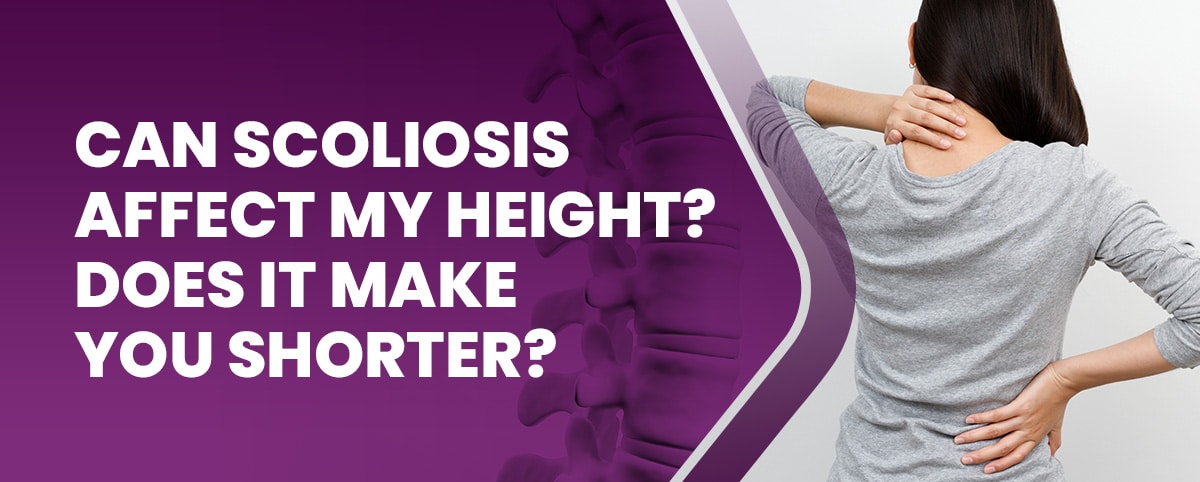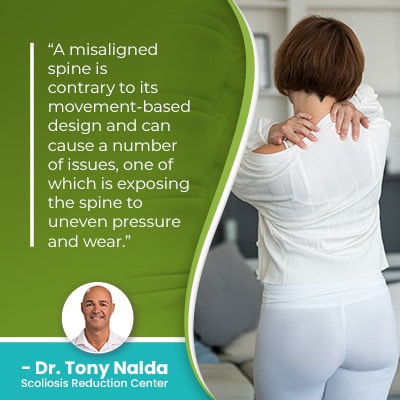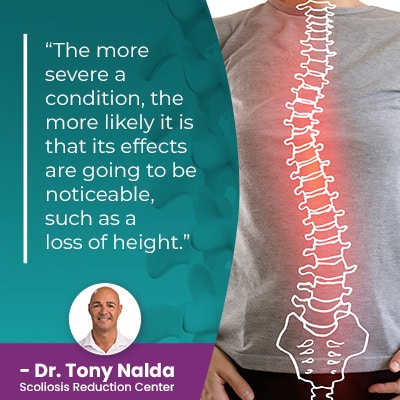Can Scoliosis Affect My Height? Does It Make You Shorter?

While a certain level of natural age-related spinal degeneration is expected and can affect a person’s height, when scoliosis is present, the rate/level of that degeneration can increase. Continue reading to find out how an unnaturally-curved spine can make you shorter, and how best to avoid this condition-effect.
As an unnatural spinal curve, scoliosis introduces a lot of uneven forces to the body; this can cause a number of symptoms and effects. Scoliosis can affect height by making it difficult to stand upright and/or by causing the spinal discs to degenerate, become desiccated, and lose height.
Although scoliosis is a spinal condition, its effects can be felt throughout the body, so let’s start with what’s going on inside the body of someone recently diagnosed.
Table of Contents
Diagnosing Scoliosis
Diagnosing scoliosis isn’t always easy; in fact, in many cases, by the time a patient is brought to me for a diagnosis and treatment, they’ve already experienced progression.
As a progressive condition, scoliosis has it in its nature to worsen over time, particularly if left untreated, or not treated proactively.
To reach a diagnosis of scoliosis, an unnatural spinal curve that bends to the side, and also rotates, has developed, and a scoliotic curve has to be of a minimum size to be considered a true scoliosis.
The size and severity of an unnatural scoliotic curve is determined by a measurement known as Cobb angle, and this is taken during X-ray by drawing lines from the tops and bottoms of the curve’s most-tilted vertebrae.
When the spine is aligned as it should be, its vertebrae are stacked on top of one another, but when one or more vertebral bodies become tilted, their position has shifted them out of alignment with the rest of the spine.
 A misaligned spine is contrary to its movement-based design and can cause a number of issues, one of which is exposing the spine to uneven pressure and wear.
A misaligned spine is contrary to its movement-based design and can cause a number of issues, one of which is exposing the spine to uneven pressure and wear.
A patient’s Cobb angle tells me how far out of alignment the spine is and classifies conditions based on severity:
- Mild scoliosis: Cobb angle measurement of between 10 and 25 degrees
- Moderate scoliosis: Cobb angle measurement of between 25 and 40 degrees
- Severe scoliosis: Cobb angle measurement of 40+ degrees
- Very-severe scoliosis: Cobb angle measurement of 80+ degrees
 The more severe a condition, the more likely it is that its effects are going to be noticeable, such as a loss of height.
The more severe a condition, the more likely it is that its effects are going to be noticeable, such as a loss of height.
In mild cases that aren’t commonly associated with pain and/or functional deficits, it can be difficult for anyone, other than a trained expert, to recognize the condition’s early indicators.
So now let’s talk about the anatomy of a healthy spine and how the changes scoliosis causes can affect height and make you shorter.
Spinal Anatomy
As mentioned, in a healthy spine, its vertebrae (bones) are stacked on top of one another in a straight and neutral alignment.
There are three main spinal sections: cervical spine (neck), thoracic spine (middle/upper back), and the lumbar spine (lower back).
Scoliosis can develop in any of the main spinal sections, although it’s most common in the thoracic spine, as the largest spinal section, and it can develop in more than one section as a combined scoliosis; this is the case with thoracolumbar scoliosis that develops in the lower thoracic spine and the upper lumbar section.
How Does Scoliosis Affect Height?
Vertebrae (bones of the spine) are separated by an intervertebral disc, and the spinal discs are key to the spine’s overall health and function.
The discs provide cushioning between adjacent vertebrae to prevent friction during activity; they provide the spine with structure as adjacent vertebrae attach to the disc in between, combine forces to enable flexible movement, and act as the spine’s shock absorbers.
When the spine starts to experience natural age-related degeneration, the discs are often the first spinal structures to feel the effects.
If you picture an intervertebral disc as a marshmallow held between two crackers, you can see how the size and shape of the marshmallow will affect the position of the crackers attached, and also how pressure coming from either of the crackers could compress and change the shape/height of the marshmallow between them.
If a disc is starting to degenerate, it often becomes desiccated and changes shape as a result, often losing height.
Scoliosis introduces a lot of uneven forces to the spine and body, and as a scoliotic curve develops, it affects how stress is distributed and absorbed by the spine, and this can cause disc degeneration that affects adjacent vertebrae and can make it more difficult to fully elongate the spine and stand up straight, contributing to a loss of trunk height.
In addition, as a scoliotic curve bends and twists unnaturally, even before disc degeneration is experienced, just the fact that the spine is misaligned and bending to the side can make it difficult for a person to stand fully erect, and this can also make a person shorter.
There are also different types of scoliosis to consider, as some are more likely to affect height than others.
Scoliosis Type and Height
One of the reasons scoliosis is often deemed a complex condition to treat is not only because it ranges widely in severity and affects all ages, but because there are also different types a person can develop, based on causation.
Some types of scoliosis are more likely to noticeably affect height, and the more severe a condition is, the more noticeable a loss of height is likely to be.
The main types of scoliosis are idiopathic, neuromuscular, degenerative, and congenital.
Adolescent idiopathic scoliosis (AIS), diagnosed between the ages of 10 and 18, is the most prevalent form of scoliosis overall, but the effect of scoliosis on height is difficult to gauge in children because they are constantly growing.
Neuromuscular scoliosis is an atypical form because it’s caused by an underlying neuromuscular condition (cerebral palsy, muscular dystrophy, spina bifida), making it particularly severe and complex to treat.
In these cases, the condition involves a disconnect between the brain, connective tissues, and muscles that support the spine, and while it can range in severity, patients can become non-ambulatory (unable to move and walk on their own) and wheelchair-bound.
So people with neuromuscular scoliosis can experience a significant loss of height from becoming non-ambulatory and because these cases of scoliosis are atypical and generally quite severe.
With degenerative scoliosis, we’re talking about adults over the age of 50 who are experiencing natural age-related spinal degeneration, and as mentioned earlier, the spinal discs are generally the first parts of the spine to experience deterioration, and disc issues can contribute to a loss of height as they become desiccated, lose height, and affect the positioning of adjacent vertebrae.
Congenital scoliosis affects infants who are born with the condition, and this is caused by a malformation within the spine itself, so again, difficult to monitor and assess how/if height is affected over time.
Conclusion
As one of the many roles of the spine is to help us stand upright and practice good posture, what happens to height and posture when a spinal condition like scoliosis develops?
To clearly answer the question, can scoliosis affect my height: yes, it can, but isn’t guaranteed to do so, particularly in mild forms or when proactive treatment has been applied successfully.
Patient/condition variables that increase the likelihood that scoliosis will affect a person’s height are patient age, condition type, and severity.
The older a scoliosis patient is, the more natural age-related spinal degeneration comes into play, making conditions more severe and affecting the ability to stand up straight, and when spinal discs have lost fluid and shrunk, over time, this can also contribute to a loss of vertical trunk height.
Again, an accurate idea of how scoliosis affects height in children is unclear because as they haven't reached skeletal maturity, their spines are experiencing a constant lengthening motion, so it is difficult to monitor and assess clearly.
Patients with particularly severe forms of scoliosis, as often occurs with cases of neuromuscular scoliosis, are more vulnerable to a noticeable loss of height because the scoliosis develops as a secondary complication of a neuromuscular condition.
Some neuromuscular scoliosis patients lose the ability to stand up on their own and/or stand up straight.
While having scoliosis isn’t guaranteed to make you shorter, it can be an affect, particularly if severe and/or if left untreated.
Here at the Scoliosis Reduction Center, I want to minimize the effects of scoliosis so patients can continue to thrive in life, and this is why I apply proactive treatment as close to the time of diagnosis as possible; this is when the condition is going to be the most responsive and treatment success is the most likely.
Dr. Tony Nalda
DOCTOR OF CHIROPRACTIC
After receiving an undergraduate degree in psychology and his Doctorate of Chiropractic from Life University, Dr. Nalda settled in Celebration, Florida and proceeded to build one of Central Florida’s most successful chiropractic clinics.
His experience with patients suffering from scoliosis, and the confusion and frustration they faced, led him to seek a specialty in scoliosis care. In 2006 he completed his Intensive Care Certification from CLEAR Institute, a leading scoliosis educational and certification center.
About Dr. Tony Nalda
 Ready to explore scoliosis treatment? Contact Us Now
Ready to explore scoliosis treatment? Contact Us Now





